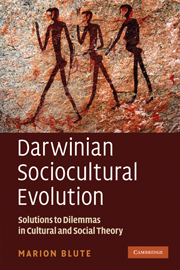Book contents
- Frontmatter
- Contents
- Preface: a postmodern metanarrative
- Acknowledgments
- 1 Introduction
- 2 History: where did something come from?
- 3 Necessity: why did it evolve?
- 4 Competition, conflict and cooperation: why and how do they interact socially?
- 5 The ideal and the material: the role of memes in evolutionary social science
- 6 Micro and macro I: the problem of agency
- 7 Micro and macro II: the problem of subjectivity
- 8 Micro and macro III: the evolution of complexity and the problem of social structure
- 9 Evolutionism and the future of the social sciences
- References
- Index
5 - The ideal and the material: the role of memes in evolutionary social science
Published online by Cambridge University Press: 05 June 2012
- Frontmatter
- Contents
- Preface: a postmodern metanarrative
- Acknowledgments
- 1 Introduction
- 2 History: where did something come from?
- 3 Necessity: why did it evolve?
- 4 Competition, conflict and cooperation: why and how do they interact socially?
- 5 The ideal and the material: the role of memes in evolutionary social science
- 6 Micro and macro I: the problem of agency
- 7 Micro and macro II: the problem of subjectivity
- 8 Micro and macro III: the evolution of complexity and the problem of social structure
- 9 Evolutionism and the future of the social sciences
- References
- Index
Summary
THE RECEPTION OF MEMETICS
The concept of evolution is central to any discussion of “memes”. It was because of the possible existence of evolutionary processes beyond the gene-based biological that Richard Dawkins introduced the concept (suggestive of “m” for memory and “ene” of gene-like) as a possible substrate (1976:191–201, 322–31). Strangely enough he, of all people, did not initially clearly distinguish the gene and genome-like from the phene and phenome-like aspects of cultural evolution, a confusion which he corrected thereafter (e.g. 2003:119–127). The meme concept spread rapidly in popular culture. In his foreword to Blackmore (1999), Dawkins reported almost as many Google hits for “memetic” as for “sociobiology”. However, it was generally not enthusiastically received in academic circles. Books on memetics (of which there have been at least seven – Brodie 1996; Lynch 1996; Blackmore 1999; Aunger 2000; Cullen 2000; Aunger 2002; Distin 2005) were interdisciplinary, which can itself be a problem. They often ignored many of the conventions of academic discourse, were sometimes written by non-professionals for a popular audience, and they were commonly viewed by social scientists, when they paid any attention at all, as yet another (post-sociobiology) incursion by biologists into their subject matter. In addition, a fratricidal war between adherents of the gene-like biologically adaptive view (which can most obviously be associated with vertical transmission) and adherents of the virus-like biologically maladaptive view (which can most obviously be associated with horizontal transmission) did not help when it should have been obvious that both are possible (see Chapter 9).
- Type
- Chapter
- Information
- Darwinian Sociocultural EvolutionSolutions to Dilemmas in Cultural and Social Theory, pp. 113 - 137Publisher: Cambridge University PressPrint publication year: 2010



